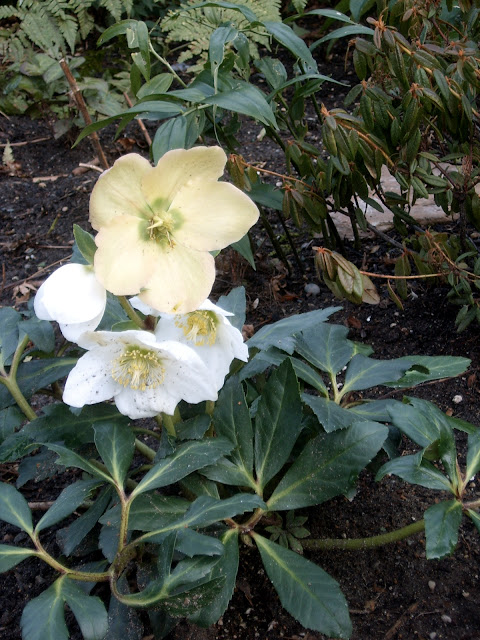HELLEBORUS is a a plant that would have to be created if it did not exist already. Hellebore are evergreen perennials that bloom throughout the winter. In Seattle HELLEBORUS niger, the Christmas rose, begins blooming in December. HELLEBORUS orientalis, the Lenton rose, and its hybrids, bloom late January or early February through April. The flowers are lovely, the leaves evergreen, maintenance easy.
Hellebore need shade in the summer, regular watering, and rich soil (however, mulch around them and keep the compost from touching the plants). The leaves can become unsightly--they are susceptible to blackspot--but you can cut them off if they do not look good and the plant will be fine. That is the extent of the work these plants need.
The hellebore above is planted under a bloodtwig dogwood (CORNUS sanguinea 'midwinter fire.'). Because hellebore like summer shade and are low maintenance they happily grow beneath deciduous trees and shrubs.
The hybrid hellebore is "black," (this particular black-flowering hellebore has quite a blue cast to it; I try to buy hellebore when they are blooming so the color doesn't surprise me).
I love black flowers and foliage, but one does have to be careful about placing them, especially in the winter, so that they don't disappear into the dirt. Here the near-by orange leaves of a coralbell (HEUCHERA) and the upright foliage of a daffodil help the hellebore get the attention it deserves. And the pale to vivid orange branches of the dogwood arching over the black flowers create drama.
This planting is beside the steps leading to a front door. Black flowers cannot be seen from a distance so I always try to plant them near a walkway.
This HELLEBORUS is niger 'josef lemper,' which usually begins blooming in December. For many gardeners 'josef' is superior to the original because its flowers face out and are upright. The five petals are really sepals, (which usually enclose the petals), and at the center are nectaries, (petals modified to hold nectar).
The above is one of three 'josef' hellebore planted just before Christmas at the corner of a front garden bed. They will continue to bloom for two or three months. The pure white flower is a good contrast to the plant's dark green leaves, and especially to the draped leaves of the rhododendron behind it. And I love the soft green at the center. The white causes the flower to stand out and the green softens the distinction and connects with the foliage all around the plant.
For me hellebore are like a light drawing one into the garden, leading one through winter.



No comments:
Post a Comment